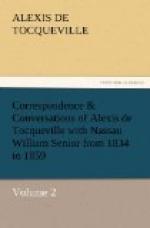Friday, April 7.—We drove to-day along the Loire to Langrais, about twelve miles below Tours.
Here is a castle of the thirteenth century, consisting of two centre and two corner towers, and a curtain between them, terminating in a rocky promontory. Nothing can be more perfect than the masonry, or more elegant than the few ornaments. The outside is covered with marks of bullets, which appear to have rattled against it with little effect.
On our return we visited the castles of Cinq Mars and Luynes. Langrais, Cinq Mars, and Luynes were all the property of Effiat, Marquis of Cinq Mars, who with De Thou conspired against Richelieu in the latter part of Louis XIII.’s reign, and was beheaded. The towers of Cinq Mars were, in the words of his sentence, ‘rasees a la hauteur de l’infamie,’ and remain now cut down to half their original height. Luynes stands finely, crowning a knoll overlooking the Loire. It is square, with twelve towers, two on each side and four in the corners, and a vast ditch, and must have been strong. Nearly a mile from it are the remains of a Roman aqueduct, of which about thirty piers and six perfect arches remain. It is of stone, except the arches, which have a mixture of brick. The peasants, by digging under the foundations, are rapidly destroying it. An old man told us that he had seen six or seven piers tumble. A little nearer to Tours is the Pile de Cinq Mars, a solid, nearly square tower of Roman brickwork more than ninety feet high, and about twelve feet by fourteen feet thick. On one side there appear to have been inscriptions or bas-reliefs. Ampere believes it to have been a Roman tomb; but the antiquaries are divided and perplexed. Being absolutely solid, it could not have been built for any use.
I am struck during my walks and drives by the appearance of prosperity. The country about Tours is dotted with country-houses, quite as numerous as in any part of England. In St. Cyr alone there must be between twenty and thirty, and the houses of the peasants are far better than the best cottages of English labourers. Everyone seems to have attached to it a considerable piece of land, from ten acres to two, cultivated in vines, vegetables and fruit. These and green crops are nearly the only produce; there is very little grain. All the persons whom I met appeared to be healthy and well-clad. The soil and climate are good, and the proximity to Tours insures a market; but physical advantages are not enough to insure prosperity. The neighbourhood of Cork enjoys a good climate, soil, and market, but the inhabitants are not prosperous.
After some discussion Tocqueville agreed with me in attributing the comfort of the Tourainese to the slowness with which population increases. In the commune of Tocqueville the births are only three to a marriage, but both Monsieur and Madame de Tocqueville think that the number of children here is still less. I scarcely meet any.




